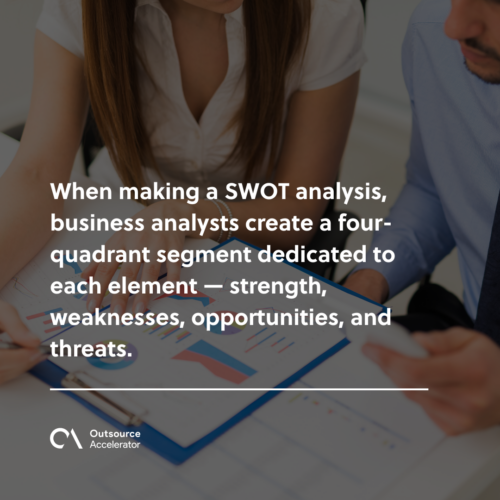SWOT Analysis
Definition
What is SWOT Analysis?
A SWOT (strengths, weaknesses, opportunities, and threats) analysis is a planning process that helps evaluate a company’s competitiveness and determine what new leads to pursue.
Its primary objective is to help organizations develop a full awareness of all the factors involved in decision-making.
You can use SWOT analysis to make the best of what your business has and convert them to your great advantage.
With this technique, you can reduce the chance of failure by understanding what your business cannot do and avoid possible backlogs and hazards.
SWOT analysis can be applied to a company, organization, or any business project and used as a guide for business growth.

Characteristics of SWOT Analysis
A SWOT analysis is one of the most useful tools for business owners. It allows a company to identify the positive and negative elements that affect its business operations.
When making a SWOT analysis, business analysts create a four-quadrant segment dedicated to each element — strength, weaknesses, opportunities, and threats.
Internal Factors
Strengths (S) and weaknesses (W) refer to internal factors of the SWOT analysis in which the resources and experience are already in the organization.
Internal factors are the resources that are already within the company. This often serves as a great source of information.
Internal factors include human resources, finance department, assets, and operations.
Strengths
Strengths describe the uniqueness of your brand and what your business does in comparison to your competitors.
Your strength might be your loyal customer base, use of advanced technology, or being a leading brand.
Strengths can be something intangible, such as excellent leadership, staff motivation, great team, efficient business operation, or even your company’s brand attributes and unique selling proposition.
Weaknesses
Weaknesses hinder an organization from performing at its greatest potential.
There are areas in business that need to be improved in order to remain competitive. This might include weak branding, high debt, poor customer service, ineffective management, or lack of finances.
Weaknesses are included in the analysis so you can improve your customer service and management. This is where you explore how and why your competitors are doing better than you.
External Factors
External factors are typically the things that you or your business cannot control. Factors like market changes, insufficient supply chain, and economic crisis greatly affect your business.
The things that happen outside your company are also important to the success of your business, whether these factors are connected directly or indirectly to an opportunity (O) or threat (T).
Opportunities
Opportunities refer to any chances that could contribute to your success. They usually arise out of nowhere so it requires an eye for monitoring trends to easily figure them out.
The ability to identify opportunities can make a huge difference to your organization. It can help your business stand out from other market competitors.
Threats
Threats are the factors that can potentially harm your business. These occur unexpectedly and are beyond your control.
Some threats you may encounter are rising costs for materials, increasing competition, natural disasters, supply chain problems, and economic downfall.
It is crucial to identify threats so you could prepare to take action before they hit your business.

How to do a SWOT Analysis the right way?
Conducting a SWOT analysis is not easy. To completely carry out and understand the analysis, you might want to gather a team to work on it.
Here’s how to do a SWOT analysis the right way.
Gather the right people
Gather people from different departments in your organization and make sure that you have representatives from every department and team.
Different groups within your organization will have different viewpoints which will be critical to making your SWOT analysis successful.
Collect ideas
After forming the right team, it is now time to brainstorm the ideas. You can collect all the ideas that each of your team members gives and identify similar items.
This way, you can ensure that all voices are heard. You or anyone from your team can even add additional notes along the way.
Rate the ideas
Once you gather all ideas, the next thing to do is rate the effectiveness of those ideas. You may use a voting system for this part of the planning. You can arrange ideas according to their rating and let the person in charge make the final decisions.
When should you perform a SWOT Analysis?
It’s best to execute a SWOT analysis before you make a big business decision. Check your current business situation so you can take your findings into account when exploring new opportunities, considering improvements, understanding your competitors, or taking risks for possible profit.
Doing SWOT analysis may be simple, but it helps your business do well, minimize risks, and take advantage of opportunities that can help you grow your business.







 Independent
Independent




